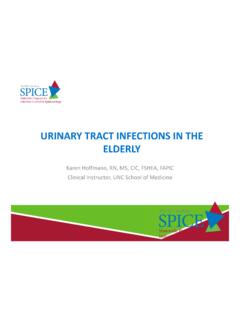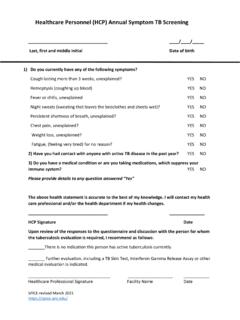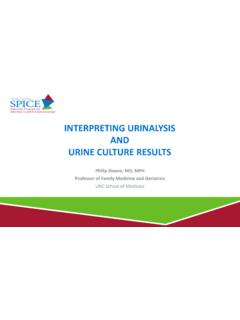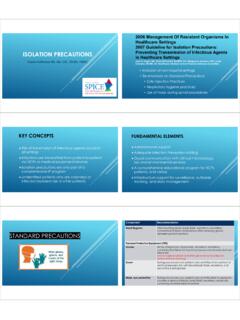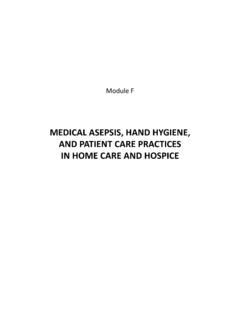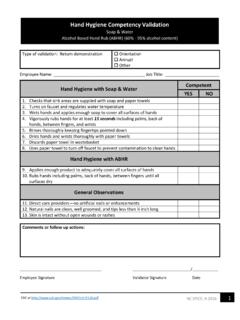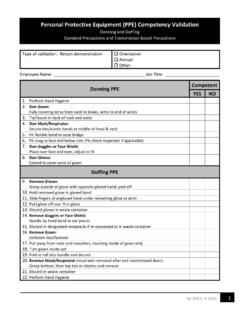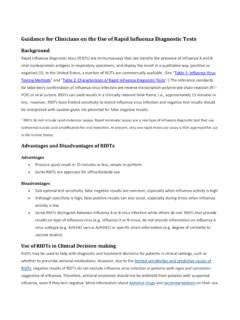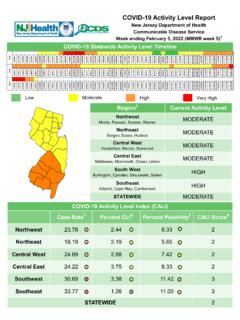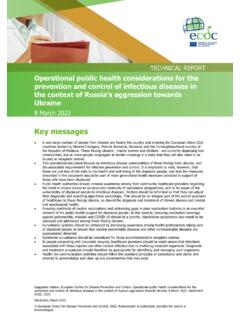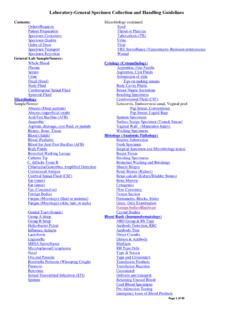Transcription of SURVEILLANCE TECHNIQUES AND METHODOLOGIES
1 SURVEILLANCE TECHNIQUES AND METHODOLOGIESE velyn Cook, RN, CICSPICEG oals of SURVEILLANCE Lecture Describe the recommended practices for SURVEILLANCE List the elements required for an organization SURVEILLANCE system Describe standardized definitions used for SURVEILLANCE Apply information to case studiesKey Concepts SURVEILLANCE is an essential component of an effective infection prevention program. Should be based on sound epidemiological and statistical principles Should be designed in accordance with current recommended practices and consist of defined elements Plays a critical role in identifying outbreaks, emerging infectious disease and bioterrorist eventsDefinitions Continual observation of a person or group, especially one suspected of doing something illegal (Bing Dictionary) Is the monitoring of thebehavior, activities, or other changing information, usually of people for the purpose of influencing, managing, directing, or protecting.
2 (Wikipedia) Local IP Definitions cont d Disease surveillanceis an epidemiologic practice by which the spread of disease, is monitored in order to establish patterns of progression. The main role of disease SURVEILLANCE is to predict, observe, and minimize the harm caused by outbreak, epidemic, and pandemic situations, as well as increase knowledge about which factors contribute to such circumstances. A key part of modern disease SURVEILLANCE is the practice ofdisease case DepartmentDefinition cont d SURVEILLANCE is a comprehensive method of measuring outcomes and related processes of care, analyzing the data, and providing information to members of the healthcare team to assist in improving those outcomes and processes Observation Monitor behavior Establish patterns/trends Measure outcomes, processes; Analyze data; feedback of data to improve outcomes and processesEvolution of SURVEILLANCE Programs 1958: AHA recommended in response to outbreaks of Staphylococcus aureus infections in hospitals.
3 1960 s: CDC recommended hospital base programs include SURVEILLANCE 1976: TJC first included infection SURVEILLANCE , prevention and control standards in its accreditation manualThe SENIC Project. Study on the Efficacy of Nosocomial Infection Control. CDC undertook in 1974 Three primary objectives: 1) to determine whether (and, if so, to what degree) the implementation of infection SURVEILLANCE and control programs (ISCPs) has lowered the rate of nosocomial infection, 2) to describe the current status of ISCPs and infection rates, and 3) to demonstrate the relationships among characteristics of hospitals and patients, components of ISCPs, and changes in the infection Findings SENIC found that hospitals reduced their nosocomial infection rates by approximately 32% if their infection SURVEILLANCE and control program included four components.
4 1) appropriate emphases on SURVEILLANCE activities and vigorous control efforts, 2) at least one full time infection control practitioner per 250 beds, 3) a trained hospital epidemiologist, and 4) for surgical wound infections (SWIs), feedback of wound infection rates to practicing for conductingSurveillance Determine baseline (endemic) Early detection of epidemics (adverse outcomes) Assess the effectiveness of prevention and control measures Monitor the occurrence of adverse outcomes to identify risk factors Observe practices to promote compliance Target performance improvement Compliance with regulations and accrediting agencies (including health department) Monitor bioterrorism events Provide information for the education of healthcare personnel APIC Text, 2015 New Developments in HAI SURVEILLANCE [Past Decade] Continuing shift from acute care to ambulatory, LTCF Decreased LOS across continuum of care Emerging and reemerging infectious diseases Bioterroism and syndromic SURVEILLANCE Use of SURVEILLANCE data to monitor non infectious events Active SURVEILLANCE culturing Culture change promotes moving beyond benchmarking and aiming for zero HAIsNational Healthcare Safety Network (NHSN) NHSN is an internet based SURVEILLANCE system that integrates the SURVEILLANCE systems previously managed separately in the Division of Healthcare Quality Promotion (DHQP) at CDC National Nosocomial Infections SURVEILLANCE (NNIS)
5 System Dialysis SURVEILLANCE Network (DSN) National SURVEILLANCE System for Healthcare Workers (NaSH)Purposes of NHSNO riginal Collect data from a sample of US healthcare facilities to permit valid estimation of the magnitude of adverse events among patients and healthcare personnel adherence to practices known to be associated with prevention of healthcare associated infections (HAI) Analyze and report collected data to permit recognition of trendsPurposes of NHSN Provide facilities with risk adjusted data that can be used for inter facility comparisons and local quality improvement activities Assist facilities in developing SURVEILLANCE and analysis methods that permit timely recognition of patient and healthcare personnel safety problems and prompt intervention with appropriate measures Conduct collaborative research studies with membersPurposes of NHSN Ongoing Facilities that participate in certain reporting programs operated by the Centers for Medicare and Medicaid Services (CMS) do so through use of NHSN.
6 Furthermore, some states use NHSN as a means for healthcare facilities to submit data on healthcare associated infections (HAIs) mandated through their specific state legislation. The Essentials of SURVEILLANCE Know the protocol/criteria Consistently apply the criteria report events meeting criteria; exclude those that don t Failure to do so: Breach of NHSN Rules of Behavior Decreased usefulness of national comparative data Unfair comparisons between facilities Possible validation discrepancies Potential impact of CMS Inpatient quality Reporting score and facility reimbursement Concerns about the criteria should be sent to NHSN NOT addressed by non reporting of events or facility adjudicationThe Basics of NHSN Patient Safety Component SURVEILLANCE and Updates for 2017: Kathy Allen BridsonNHSN ComponentsPatient SafetyHCP SafetyBiovigilanceLT C FDevice-associated moduleProcedure-associated moduleAntimicrobial Use and Resistance ModuleMDRO/CDI ModuleBBF ExposureInfluenza VaccinationOP DialysisMDRO/C diff LabIDUTIP revention Process MeasuresPatient Safety Component Modules Device associated CLABSI Central line associated bloodstream infection CLIP Central line insertion practices VAE Ventilator associated events (adult locations only) VAP Ventilator associated pneumonia (in pediatric locations (in plan or off plan), or NICU and adult locations (off plan) CAUTI Catheter associated urinary tract infection Procedure associated SSIP atient Safety Component Modules Antimicrobial Use and Resistance (AUR))
7 The primary objective of the Antimicrobial Use option is to facilitate risk adjusted inter and intra facility benchmarking of antimicrobial usage. A secondary objective is to evaluate trends of antimicrobial usage over time at the facility and national levels Patient Safety Component Modules Choices for Multidrug resistant organism (MDRO) and CDI Module: LabID Event : (MRSA & C difficile) Infection SURVEILLANCE Prevention Process Measures Active SURVEILLANCE TestingData Collection and Reporting Requirements for Patient Safety Component1. Submit a Monthly Reporting Plan to inform CDC which, if any, of the patient safety modules will be used for that Adhere to the selected module s protocol(s) exactly as described in the NHSN Manual Patient Safety Component Protocol3. Use SURVEILLANCE methodology as describedintheProtocolData Collection and Reporting Requirements for Patient Safety events and appropriate summary or denominator data indicated on the Plan to CDC within 30 days of the end of the data for at least one module for a minimum of 6 months of the calendar an annual survey for your quality control acceptance checks that assess the data for completeness and to report to state health authorities adverse event outbreaks identified in the facility by the SURVEILLANCE system and about which you are contacted by of SURVEILLANCE Total (or Whole) House SURVEILLANCE All HAIs are monitored in the entire population Calculate rates for specific population (not an overall facility wide rate)
8 Targeted SURVEILLANCE Particular care units Infections related to medical devices Organisms of epidemiological importance Combination SURVEILLANCE Strategy Most use a combination and monitor targeted events that occur in defined populations while concurrently monitoring select HAIs and laboratory reports from house wide locationsExamples might be MRSA and C difficile house wide but CAUTIs in the ICU Methods *Results with MS versus ES (HAIs in ICU) were: Sensitivity 40% vs 87% Specificity 94% vs 99%*Effectiveness of an automated SURVEILLANCE system for intensive care unit-acquired infections: Vienna , Austria; 2006-2007 APIC Position Paper: The Importance of SURVEILLANCE Technologies in the Prevention of Healthcare Associated Infections (HAIs) Streamline and facilitate efficient review of relevant data, promoting rapid identification of sentinel events and detection of outbreaks Expand and better define the scope of infection prevention activities Reduce infection prevention department time spent on SURVEILLANCE and clerical tasks Improve response to public health issues Regulatory compliance Financial performance Potential to enhance antibiotic stewardship programsRecommended Practices for the population the outcome or process for SURVEILLANCE and determine the time period SURVEILLANCE SURVEILLANCE and analyze infection risk stratification and use SURVEILLANCE SURVEILLANCE METHODOLOGIES and findingsICRAICRA*Note.
9 In-plan SURVEILLANCE means that the facility has committed to following the NHSN SURVEILLANCE protocol, in its entirety, for that particular event, as shown in the facility s NHSN monthly reporting plan. Off-plan SURVEILLANCE is SURVEILLANCE that is done because a facility has decided to track a particular event for internal use. Data that are entered into NHSN off-plan are not included in NSHN annual reports or other NHSN publications. A facility makes no commitment to follow the NHSN protocol for off-plan events. Using SURVEILLANCE Definitions Define clearly all data elements outcome or process at risk population risk factors Use standardized written case definition (These are SURVEILLANCE definitions and not clinical definitions!!!!!) If definition (CDC NHSN) change, highlight in reports (remember mandatory reporting)Others may be trained to screen data sources for these infections, but the IP must make the final determination.
10 (NHSN)Key TermsSSILabIDVAEI nfection Window PeriodNADate of EventYesPOANAHAINAR epeat Infection Time Period NA Secondary BSI Attribution Period*Not ApplicableNot Applicable*See SSI specific guidanceKey Terms NHSN Infection Window Period: Defined as the 7 days during which all site specific infection criteria must be met. It includes the day the first positive diagnostic test that is an element of the site specific infection criterion, was obtained, the 3 calendar days before and the 3 calendar days after. For site specific infection criteria that do not include a diagnostic test, the first documented localized sign or symptom that is an element of NHSN infection criterion should be use define the window Date of Event: The date the firstelement used to meet an NHSN site specific infection criterion occurs for the firsttime within the seven day infection window periodInfection window period Diagnostic test examples* Laboratory specimen collection Imaging test Procedure or exam Physician diagnosis Initiation of treatment Localized sign or symptom examples: Diarrhea Site specific pain Purulent exudateIf there is more than one use the most localizing test result, , if trying to determine MBI LC



